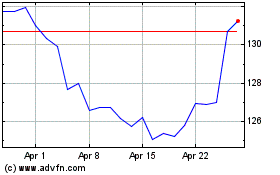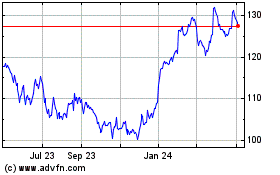Merck Provides Update on Strategic Actions to Transform the Company & Build a Platform for Sustained Future Growth at the 33r...
January 12 2015 - 7:00AM
Business Wire
- KEYTRUDA, First FDA-Approved Anti-PD-1
Therapy, Filed and Launched Within Five Months
- Company Expects to Submit sBLA for
KEYTRUDA in Mid-Year 2015 for Advanced Non-Small Cell Lung
Cancer
- NDA Submission for Hepatitis C
Combination Regimen, Grazoprevir/Elbasvir (MK-5172/MK-8742),
Planned for First Half of 2015
- Seven New Products were Approved in
2014
- Company Announced Acquisition of
Cubist, Acquired Idenix and Divested its Consumer Care
Business
- Targeted Cost Savings are on Track to
be Realized by the End of 2015
Merck (NYSE:MRK), known as MSD outside the United States and
Canada, today will report on the ongoing execution of its
multi-year, strategic initiative to sharpen its commercial and
research and development (R&D) focus, redesign its operating
model and reduce its cost base. In October 2013, Merck launched its
global initiative to transform the company into a more competitive
and innovative company and to build a platform for sustained future
growth.
“Over the past 15 months, we’ve seen the results of our
transformation strategy, including advancing major pipeline
candidates, completing multiple business development actions and
securing first-in-class product approvals,” said Kenneth C.
Frazier, chairman and chief executive officer, Merck. “As a result
of our strong and continued commitment to the pursuit of science
and R&D, our labs are focused on many of the most innovative
areas in biomedical research today, which we believe is the best
way to create intrinsic value for both society and for our
shareholders.”
Positioned for Long-Term Growth Through Innovation
As a result of prioritizing its research efforts in the core
areas where it can make the most impact on addressing critical
areas of unmet medical need, Merck is now focused on many of the
world’s most urgent global health challenges, including
immuno-oncology, hepatitis C, cardiometabolic disease,
antimicrobial resistance and Alzheimer’s disease. Merck accelerated
several of its key clinical programs in 2014, positioning the
company for long-term growth.
- In addition to being the first
anti-PD-1 therapy approved in the United States, KEYTRUDA
(pembrolizumab) received Breakthrough Therapy Designation from the
U.S. Food and Drug Administration (FDA) in two tumor types:
advanced melanoma and advanced non-small cell lung cancer
(NSCLC).
- In mid-year 2015, Merck expects to
submit a supplemental Biologics License Application (sBLA) to the
FDA for KEYTRUDA for the treatment of patients with Epidermal
Growth Factor Receptor (EGFR) mutation-negative and Anaplastic
Lymphoma Kinase (ALK) rearrangement-negative NSCLC whose disease
has progressed on or following platinum-containing
chemotherapy.
- In 2014, Merck engaged in multiple
research collaborations in oncology, and data for KEYTRUDA was
presented in seven different types of cancer. KEYTRUDA continues to
be studied in more than 30 cancers and in 20 combination
settings.
Merck also continued to accelerate its R&D efforts in its
other core areas of focus, such as hepatitis C.
- The company expects to file a New Drug
Application (NDA) with the FDA in the first half of 2015 for
grazoprevir/elbasvir (MK-5172/MK-8742), the company’s
investigational oral, once-daily combination regimen for the
treatment of chronic hepatitis C virus (HCV) infection.
- Merck bolstered its hepatitis pipeline
in 2014 by acquiring Idenix Pharmaceuticals.
- As a result of the acquisition, the
Phase 2 C-CREST studies (NCT02332707 and NCT02332720) have been
initiated to study combination regimens of grazoprevir and MK-3682
(formerly IDX21437) with either elbasvir or MK-8408 for the
treatment of HCV infection.
In total, Merck now has more than 10 Phase 3 clinical programs
in its core therapeutic areas, as well as in other areas with
significant potential such as Alzheimer’s disease, and has multiple
strategic collaborations.
- Merck recently initiated its first
Phase 3 study (NCT02275780) of doravirine (MK-1439), an
investigational HIV medicine.
- In addition to oncology collaborations,
Merck also initiated several other clinical research collaborations
in 2014, such as working with NewLink on the development of an
investigational Ebola vaccine and a cardiovascular-focused
collaboration with Bayer.
Focused Commercial Strategy Provides a Strong Platform for
Growth and Leadership
Additionally, Merck has taken several steps to create and
maximize near- and longer-term commercial leadership opportunities
that create value for sustained growth.
- The initial indication for KEYTRUDA was
filed and launched in the United States within five months in 2014;
the company continues to focus efforts on this priority launch.
Additionally, filings are underway in the European Union and
globally for advanced melanoma.
- Merck bolstered its product portfolio
by entering into an agreement to acquire Cubist Pharmaceuticals, a
global leader in the discovery, development and supply of
antibiotics to treat serious and potentially life-threatening
infections.
- Following the completion of the
acquisition of Cubist in the first quarter of 2015, Merck looks
forward to launching ZERBAXA (ceftolozan/tazobactam), a recently
approved antibiotic to treat Gram-negative bacteria, a key cause of
in-hospital infections.
- In total, Merck received approval for
seven products in 2014, such as GARDASIL 9 (Human Papillomavirus
9-valent Vaccine, Recombinant) and BELSOMRA (suvorexant).
Reduced Operating Costs Drive Profitability and Investment in
Innovation and Late-Stage Portfolio
In 2014, the company’s redesigned operating model enabled Merck
to remain on track to meet its goal of realizing $2.5 billion in
annual net cost savings by the end of 2015. These savings are off
of the company’s full-year 2012 expense levels. As part of its
prioritization efforts, the company continued to review its assets
to determine whether they could provide the best short- and
longer-term value with Merck or elsewhere.
- As a result, Merck divested its
consumer care business to Bayer for $14 billion, which provided
capital to the company to better resource its core areas of focus
and return cash to shareholders.
- Merck determined its Animal Health
business remains a key growth driver and is committed to looking
for ways to augment this critical business.
- In 2014, the company continued to
streamline its physical footprint, divesting multiple sites within
its manufacturing network around the world and completing the
closures of facilities in Whitehouse Station and Summit, N.J.
About Merck
Today’s Merck is a global healthcare leader working to help the
world be well. Merck is known as MSD outside the United States and
Canada. Through our prescription medicines, vaccines, biologic
therapies and animal health products, we work with customers and
operate in more than 140 countries to deliver innovative health
solutions. We also demonstrate our commitment to increasing access
to healthcare through far-reaching policies, programs and
partnerships. For more information, visit www.merck.com and connect
with us on Twitter, Facebook and YouTube.
Merck Forward-Looking Statement
This news release includes “forward-looking statements” within
the meaning of the safe harbor provisions of the United States
Private Securities Litigation Reform Act of 1995. These statements
are based upon the current beliefs and expectations of Merck’s
management and are subject to significant risks and uncertainties.
There can be no guarantees with respect to pipeline products that
the products will receive the necessary regulatory approvals or
that they will prove to be commercially successful. If underlying
assumptions prove inaccurate or risks or uncertainties materialize,
actual results may differ materially from those set forth in the
forward-looking statements.
Risks and uncertainties include but are not limited to, general
industry conditions and competition; general economic factors,
including interest rate and currency exchange rate fluctuations;
the impact of pharmaceutical industry regulation and health care
legislation in the United States and internationally; global trends
toward health care cost containment; technological advances, new
products and patents attained by competitors; challenges inherent
in new product development, including obtaining regulatory
approval; Merck’s ability to accurately predict future market
conditions; manufacturing difficulties or delays; financial
instability of international economies and sovereign risk;
dependence on the effectiveness of Merck patents and other
protections for innovative products; and the exposure to
litigation, including patent litigation, and/or regulatory
actions.
Merck undertakes no obligation to publicly update any
forward-looking statement, whether as a result of new information,
future events or otherwise. Additional factors that could cause
results to differ materially from those described in the
forward-looking statements can be found in Merck’s 2013 Annual
Report on Form 10-K and the company’s other filings with the
Securities and Exchange Commission (SEC) available at the SEC’s
Internet site (www.sec.gov).
MerckMedia:Lainie Keller, 908-236-5036Steven Cragle,
908-740-1801orInvestors:Justin Holko, 908-740-1879Joe Romanelli,
908-740-1986
Merck (NYSE:MRK)
Historical Stock Chart
From Mar 2024 to Apr 2024

Merck (NYSE:MRK)
Historical Stock Chart
From Apr 2023 to Apr 2024
